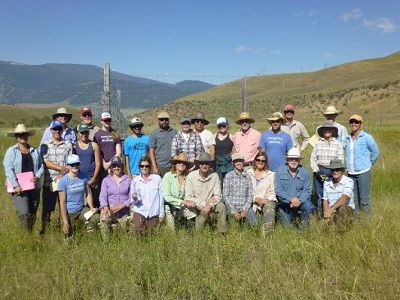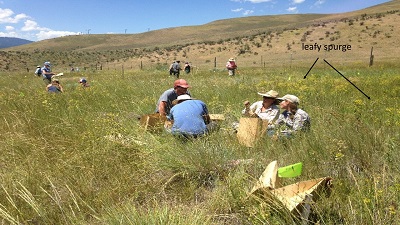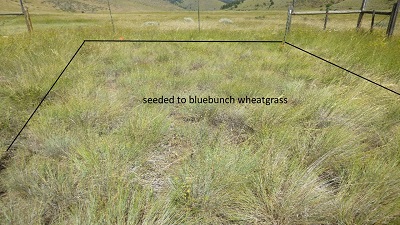Leafy Spurge Integrated Management Monitoring Day

Jane Mangold, MSU.
Introduction
Leafy spurge is one of the most widespread and difficult-to-control noxious weeds in Montana. In 2002 MSU and Missoula County Weed District began a research project near Lolo, MT, that integrated various methods to manage leafy spurge. Control methods included herbicide, revegetation, biological control, and grazing. Study plots were monitored for three years after treatment (2003-2005). In June 2016, 14 years post-treatment, 26 people gathered to sample the plots again (photo right), an excellent example of researchers and weed professionals working together to improve invasive plant management.
Materials and methods
Six grass seeding treatments and three herbicide treatments were evaluated. Each grass seeding treatment plot was 14’x45’ and divided into three 14’x15’ herbicide treatment plots. Grass treatments included bluebunch wheatgrass, big bluegrass, Great Basin wildrye, orchard grass, thickspike wheatgrass, and a non-seeded control. Herbicide treatments were picloram [Tordon (1 qt/A)], imazapic [Plateau (10 oz/A)], and a non-sprayed control. Treatments were applied fall 2002, and the area was fenced to exclude grazing by livestock and wildlife. Aphthona flea beetles are established at the site and goat grazing occurred on the plots a couple years after they were established. Monitoring has focused on abundance of seeded grasses and leafy spurge.
Short-term results (2003-2005)
Orchard grass, thickspike wheatgrass, and bluebunch wheatgrass established well followed by big bluegrass. Great Basin wildrye did not establish consistently. Grass establishment was greater when herbicides were applied, but there was no difference in effectiveness between picloram and imazapic. Leafy spurge density was reduced similarly by picloram and imazapic one year after treatment (2003); leafy spurge increased in 2004-2005, but it still remained less abundant in sprayed plots compared to non-sprayed plots. Herbicides also reduced leafy spurge biomass but the reduction depended on grass seeding treatment. The combination of spraying herbicide and seeding bluebunch wheatgrass was particularly effective, reducing leafy spurge biomass by about 50% (356 lb/A to 178 lb/A).
Long-term Results (2016)
Data collected in June 2016 (14 years post-treatment) have not yet been analyzed, but some generalizations include: Bluebunch wheatgrass remains a strong competitor with leafy spurge (photo below, left); very little orchard grass remains, but thickspike wheatgrass, big bluegrass, and Great Basin wildrye are commonly found in plots seeded to those species. Where seeded grasses established, leafy spurge is still present but no longer dominant (photo below, right). Look for more information in a Monthly Weed Post yet to come!

Jane Mangold, MSU.

Jane Magold, MSU.
